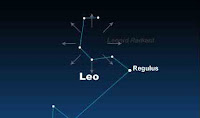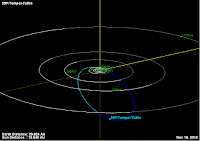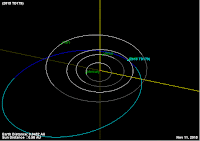Asteroid
2015 VT64 passed by the Earth at a distance of 3 772 000 km (9.68
times the average distance between the Earth and the Moon, or 2.49% of
the average distance between the Earth and the Sun), slightly before 7.15
pm on Monday 9 November 2015. There was no danger of the asteroid
hitting us, though had it done so it would have presented only a minor
threat. 2015 VT64 has an estimated equivalent diameter of 11-36 m (i.e.
it is estimated that a spherical object with the same volume would be 11-36 m in diameter), and an object of this size would be expected to
explode in an airburst (an explosion caused by superheating from
friction with the Earth's atmosphere, which is greater than that caused
by simply falling, due to the orbital momentum of the asteroid) in the
atmosphere between 30 and 12 km above the ground, with only fragmentary
material reaching the Earth's surface.
The calculated orbit of 2015 VT64. JPL Small Body Database.
2015 VT64 was discovered on 8 November 2015 (the day before its closest approach to the Earth) by the University of Arizona's Catalina Sky Survey,
which is located in the Catalina Mountains north of Tucson. The
designation 2015 VT64 implies that it was the 1619th asteroid (asteroid T64)
discovered in the first half of November 2015 (period 2015 V).
2015 VT64 has a 460 day orbital period and an eccentric orbit tilted at an
angle of 18.0° to the plane of the Solar System that takes it from 0.97
AU from the Sun (i.e. 97% of the average distance at which the Earth
orbits the Sun) to 1.36 AU from the Sun (i.e. 136% of the average
distance at which the Earth orbits the Sun). It is therefore classed as an
Apollo Group Asteroid (an asteroid that is on average further from the
Sun than the Earth, but which does get closer). This means that close
encounters between 2015 VT64 and the Earth are moderately common, with
the most recent thought to have occurred in April 2011 next predicted for April 2016.
See also...
 Leonid Meteor Shower falls this week. Each year between 15 and 18 November (approximately), typically peaking between midnight and dawn on 18 November, the the Earth
encounters the Leonid Meteors, one of...
Leonid Meteor Shower falls this week. Each year between 15 and 18 November (approximately), typically peaking between midnight and dawn on 18 November, the the Earth
encounters the Leonid Meteors, one of... Asteroid 2015 VZ2 passes the Earth. Asteroid
2015 VZ2 passed by the Earth at a distance of 5 294 000 km (10.8 times
the average distance between the Earth and the Moon, or 3.54% of the
average distance between the Earth and the Sun), slightly after 2.50 am
GMT on Sunday 8 November 2015. There...
Asteroid 2015 VZ2 passes the Earth. Asteroid
2015 VZ2 passed by the Earth at a distance of 5 294 000 km (10.8 times
the average distance between the Earth and the Moon, or 3.54% of the
average distance between the Earth and the Sun), slightly after 2.50 am
GMT on Sunday 8 November 2015. There... Asteroid 2015 TD179 passes the Earth. Asteroid
2015 TD175 passed by the Earth at a distance of 4 054 000 km (10.6
times the average distance between the Earth and the Moon, or 2.71% of
the average distance between the Earth and the Sun), slightly after 6.00
pm on Wednesday 4 November...
Asteroid 2015 TD179 passes the Earth. Asteroid
2015 TD175 passed by the Earth at a distance of 4 054 000 km (10.6
times the average distance between the Earth and the Moon, or 2.71% of
the average distance between the Earth and the Sun), slightly after 6.00
pm on Wednesday 4 November...
Follow Sciency Thoughts on Facebook.

